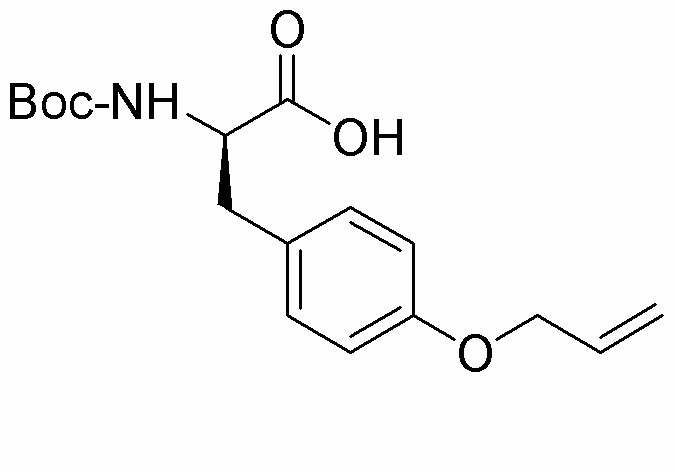Boc-O-allyl-D-tyrosine is widely utilized in research focused on:
- Peptide Synthesis: This compound serves as a valuable building block in the synthesis of peptides, particularly in the development of therapeutic agents targeting various diseases.
- Drug Development: It plays a crucial role in the pharmaceutical industry for creating novel drug candidates, especially those designed to interact with specific biological targets.
- Bioconjugation: Researchers use it for bioconjugation processes, allowing for the attachment of biomolecules to drugs or imaging agents, enhancing their efficacy and specificity.
- Protein Engineering: In the field of protein engineering, it aids in modifying proteins to improve their stability and activity, which is essential for biotechnological applications.
- Research in Neuroscience: This compound is also explored in neuroscience research, particularly in studying the role of tyrosine derivatives in neurotransmitter synthesis and function.
General Information
Properties
Safety and Regulations
Applications
Boc-O-allyl-D-tyrosine is widely utilized in research focused on:
- Peptide Synthesis: This compound serves as a valuable building block in the synthesis of peptides, particularly in the development of therapeutic agents targeting various diseases.
- Drug Development: It plays a crucial role in the pharmaceutical industry for creating novel drug candidates, especially those designed to interact with specific biological targets.
- Bioconjugation: Researchers use it for bioconjugation processes, allowing for the attachment of biomolecules to drugs or imaging agents, enhancing their efficacy and specificity.
- Protein Engineering: In the field of protein engineering, it aids in modifying proteins to improve their stability and activity, which is essential for biotechnological applications.
- Research in Neuroscience: This compound is also explored in neuroscience research, particularly in studying the role of tyrosine derivatives in neurotransmitter synthesis and function.
Documents
Safety Data Sheets (SDS)
The SDS provides comprehensive safety information on handling, storage, and disposal of the product.
Product Specification (PS)
The PS provides a comprehensive breakdown of the product’s properties, including chemical composition, physical state, purity, and storage requirements. It also details acceptable quality ranges and the product's intended applications.
Certificates of Analysis (COA)
Search for Certificates of Analysis (COA) by entering the products Lot Number. Lot and Batch Numbers can be found on a product’s label following the words ‘Lot’ or ‘Batch’.
Numéro de catalogue
Numéro de lot/série
Certificates Of Origin (COO)
This COO confirms the country where the product was manufactured, and also details the materials and components used in it and whether it is derived from natural, synthetic, or other specific sources. This certificate may be required for customs, trade, and regulatory compliance.
Numéro de catalogue
Numéro de lot/série
Safety Data Sheets (SDS)
The SDS provides comprehensive safety information on handling, storage, and disposal of the product.
DownloadProduct Specification (PS)
The PS provides a comprehensive breakdown of the product’s properties, including chemical composition, physical state, purity, and storage requirements. It also details acceptable quality ranges and the product's intended applications.
DownloadCertificates of Analysis (COA)
Search for Certificates of Analysis (COA) by entering the products Lot Number. Lot and Batch Numbers can be found on a product’s label following the words ‘Lot’ or ‘Batch’.
Numéro de catalogue
Numéro de lot/série
Certificates Of Origin (COO)
This COO confirms the country where the product was manufactured, and also details the materials and components used in it and whether it is derived from natural, synthetic, or other specific sources. This certificate may be required for customs, trade, and regulatory compliance.


